C&S Outside Metal Roofs -- Painting and Weathering Models
C&S Outside Metal Roofs -- Painting and Weathering Models
|
This post was updated on .
I felt badly about how I stepped on Keith's Ingolsby dump car thread with my thoughts on painting C&S metal roofs on models. I resolved to open a new thread to discuss this subject, and unclutter Keith's ongoing project. Keith had the same thoughts this morning.
So here goes: Keith was describing his testing of the use of chipping fluid for weathering his car. I responded: Interesting, a "modern" variation of the old rubber cement mask and peel technique for simulating old flaking paint. I agree, there's a lot to learn from the military model builders using different techniques than the traditional model railroad weathering concepts. We tend to either build up thin layers of paint, then scratch it off in random ways or build up colors on top of colors with washes, air brushing and powdered pigments. My friend Dale Kreutzer is a master of the paint and scratch technique popularized by the old Gazette articles. I'm always too heavy handed with the fiber glass eraser, get through too many layers of paint, or worse, down into grooves of scribed styrene, exposing white plastic. And with washes, I tend to get unexpected color shifts of the base coat. Same with air brush weathering, I'm just too heavy handed, and things look too exaggerated, a caricature. I've been experimenting with Mark Evans technique of using Prismacolor water color pencils, over base coats of paint. I seem to have better control. Speaking of Murphy roofs, I have found that using Prismacolor "bright silver" pencil over freight car red paint yields a medium grey, galvanized metal look. I'll post some photos tomorrow. And take care with your painted metal Murphy roofs. For decades, I labored under the misconception that the C&S metal roofs on the phase 2 and 3 house cars were left unpainted, bare galvanized metal. And that roof walks were never painted. Then I found this photo in one of Richard Dorman's RGS books:  This is the roof of an ex-C&S SUF stock car in a RGS stock train in the late 1940's. Not only is the roof still painted but very little of the galvanized metal is showing under the wear of the paint. The wooden running boards are weathered to a grey driftwood color, but there is a hint of freight car red on one of the boards to the left. The locomotive cinders, blown up against the narrow ribs is a nice detail, not sure how to duplicate it. It may be more appropriate to suggest fading of the paint on the metal roof, by direct exposure of the high altitude Colorado sun.  The roof doesn't appear to be weathered to bare metal, but a much faded shade of the body color. Same with the metal corner irons and side stake brackets. How would you artist types simulate this?? This morning, Keith replied: Jim, I too had spied those color photos in Dorman's books taken from the caboose cupola. I recall Harry Brunk shared a similar pic of a C&S train headed towards Fremont Pass from Leadville with similar cinders clinging to the Murphy roof ribs. Harry's sharp eyes had picked out the roof hatches added to a couple box cars (Oh! gotta model a couple of those someday soon too!). Since you have diverted the conversation, maybe we should start a new thread? This brings up three points of interest: 1. The cinders, obviously. 2. Roof walks, paint or no paint? 3. Weathering Murphy roofs. You photo shows the cinders behind the ribs. Being that we modelers have to glue the cinders down, it will be inevitable that the car will move in a train with the cinders to the front. Oops! But, if you want to model this feature, some fine coal, ballast or cinders should do in a drop of cement or thinned ballast cement on the car roof. I might apply with a toothpick and then sprinkle the cinder material in. It probably wouldn't hurt to work over the cinder material with a mortar and pestle or food processor to make it extra fine. I will probably do this someday to a few cars. We shall see. Earl Knoob has long maintained that roof walks were not painted because the paint would make them slippery with early morning dew or in any moisture. God knows it was tough enough for the brakie to trot across the cars without a slipping hazard. I believe they were painted, at least in the early days, because these are so darned exposed that the wood will weather extra fast without some sort of treatment. Nevertheless, I have bowed to Earl and others and started to paint my roofwalks to emulate the color of weathered wood, dusting the painted roof walks with a coat of sand or grey followed by a black or brown wash. Recall that the image in the photo above is in the late 40s/ early 50s at the twilight of the RGS; same goes for most of the C&S pics towards the end. The cars were not receiving as much care as they had earlier. To my thinking the Murphy roofs are essentially a standing seam roof system with either 11 or 13 ribs. You can see that the metal parts take the color differently than the wood. My guess is that the metal pans are galvanized. On the cupola pic there are some light spots. They look like sand, but I cannot imagine that is what it is. Cinders can be very abrasive, not to mention acidic. I would not be surprised if wind caused the cinders to abraid the metal pans creating areas of exposed galvanized metal. These would appear in colors ranging from dull silver to grey and might have areas of rust around the edges. I think that is what the light spots are we are seeing in the image. For years, I have been giving my Murphy roofs a coat of Testor's silver enamel (get some while it lasts!) as a primer, undercoat, then using the rubber cement or other devices to provide some weathering. With the chipping fluid, maybe this becomes a richer process with areas of silver and a gull grey followed by the chipping fluid, some scratching and then a small drop of rust wash which should gather towards the edge of the spot. Since the conversation has strayed this far, what do you all think of the model paint world these days? Very frustrating, eh? Dad was a Floquil man, never Scale Coat, so that is how I grew up. I had shifted to the Floquil acrylics when they got bought by Testors and discontinued. I have bought my share of Gloss Cote and Dull Cote, and had taken to having a can of Gull Grey, Flat Black and Silver on hand for small projects. Now Testors is gone. I have standardized on Vallejo acrylics and am generally happy with these, though I am still getting used to which colors to use and how they mix. Jim is a fan of the Tamiya primer in a rattle can, and I may have to investigate the Tamiya rattle can offerings the next time I visit Hobby Town to see if I can replicate the Testors products. And...since I have been watching all these military model videos I am getting really curious about MIG and AK products.... So, lets pick up this conversation in a more focused format. It is a pertinent subject, as I have used the Covid-19 shutdown in WA state to refurbish and repaint some of my old Sn3 C&S models for my 1924 C&Sn3 roster . . . I have deleted my wordy thoughts from Keith's Ingolsby thread . . . perhaps Keith can do the same with his morning post to clean things up on that thread. 
Jim Courtney
Poulsbo, WA |
Re: C&S Outside Metal Roofs -- Painting and Weathering Models
|
First, some thoughts about painted roofs and roof walks.
I, too, for years thought that C&S metal roofs and roof walks were never painted. I have built models of SUF cars with metal roofs in both HOn3 and Sn3, and tied to duplicate what I thought they looked like, painting the cast metal roofs various shades of "galvanized metal" and painted roof walks with Floquil "foundation", weathered with black and brown shoe dyes in alcohol. I thought that since un-colored basswood weathers to nice grays and browns this way, the "foundation" on textured white Evergreen styrene would duplicate the effect. Never was satisfactory. I tried using stained strip wood roof walks and laterals on "galvanized" roofs, too, but they never looked right. Finding color photos of standard gauge freight cars from the late 1930's and early 1940's made me reevaluate the whole premise. Most of us model the C&S in its last decade, and likely most of the paint had weathered off the neglected roofs and roof walks. Even when the RGS repainted and relettered the "Miller" cars in 1938, they may have only repainted the sides and ends and not bothered with the roof. Consider these photos from the Library of Congress: 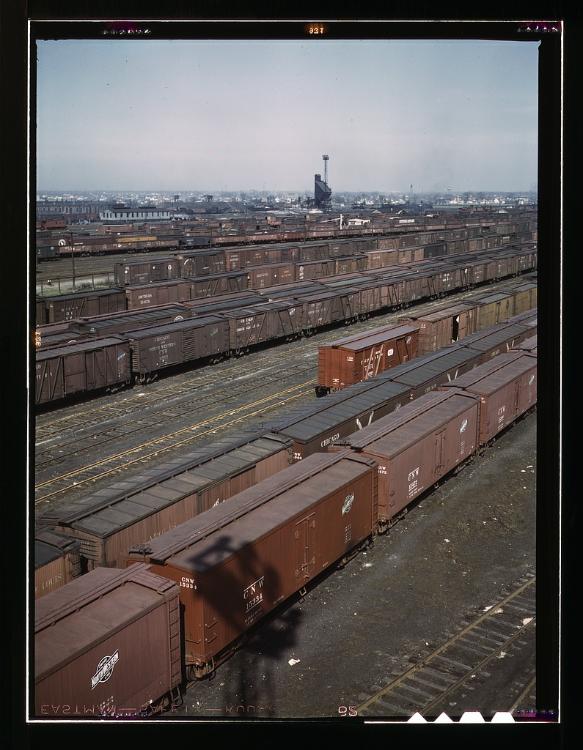 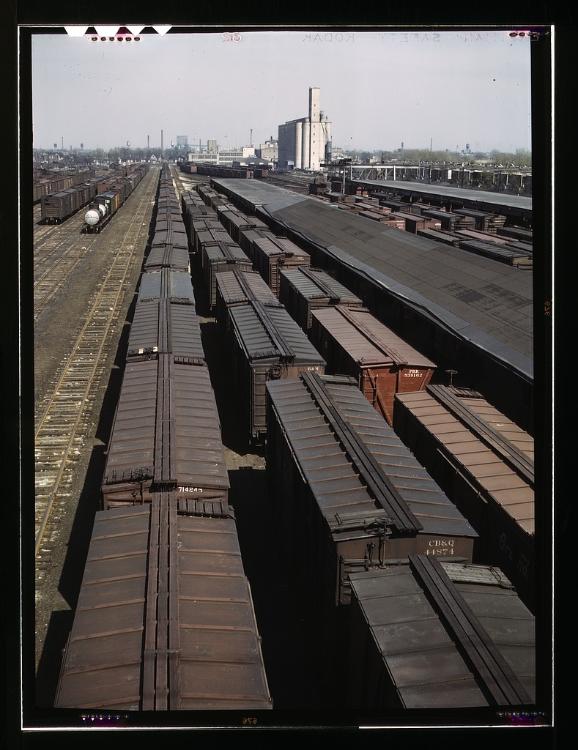 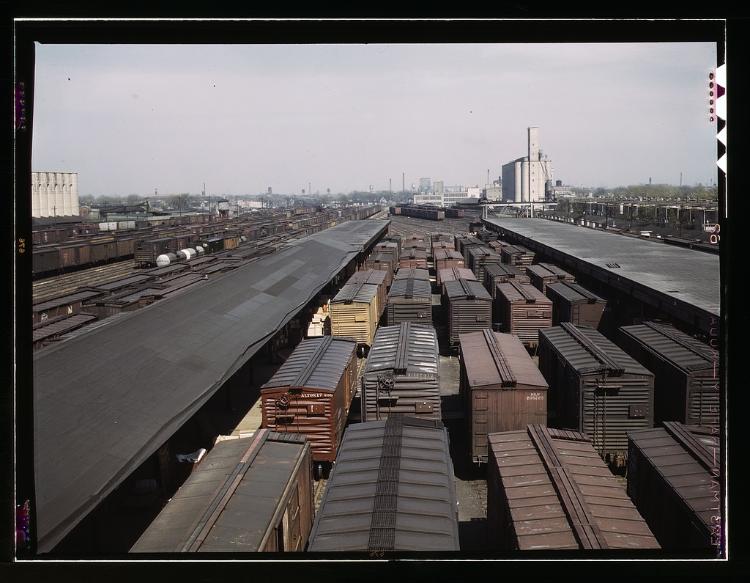 Most boxcars in these immediate pre-WWII photos have roofs (wooden and metal) fairly well maintained, most painted but dulled with coal soot. Most running boards are painted, a few show weathered wood and at least one has new bare wood replacement boards. CM Auditor pointed out when I first posted these photos in 2015: Looking at the Colorado Midland specs for box cars in both 1886 and 1890, the specification for running boards was the color of car mixed with 6 oz of find sand per gallon of paint used. So I think it is likely that all C&S metal roofs and running boards were originally painted in the first decade. Question is how were they maintained as the cars were shopped. So, two questions from my point of view, what were the prototype practices and how does the C&S modeling community paint and weather C&S roofs? Show us photos of your roofs! My current attempts are to use Prismacolor water color pencils over a base coat of PolyScale acrylic "Rock Island Maroon", my go to color for C&S freight car red. I have a stash of about 12 bottles left from c.2008. When those are gone, I will probably try Tru-Color paints that has a mix by the same name.
Jim Courtney
Poulsbo, WA |
Re: C&S Outside Metal Roofs -- Painting and Weathering Models
|
Here are a couple of PBL 3000-series boxcars with the "economy" lettering that I built to run on Dale Kreutzer's layout.
 The base coat is PBL Star brand "D&RGW Boxcar Red". I've used Prismacolor pencils to subtly weather the cars sides with umber, browns, dark grays, ala Mark Evans. To attempt weathered areas on the painted metal roofs, I used Prismacolor "Bright Silver" pencils to add areas of paint weathered off of the galvanized metal roofs: 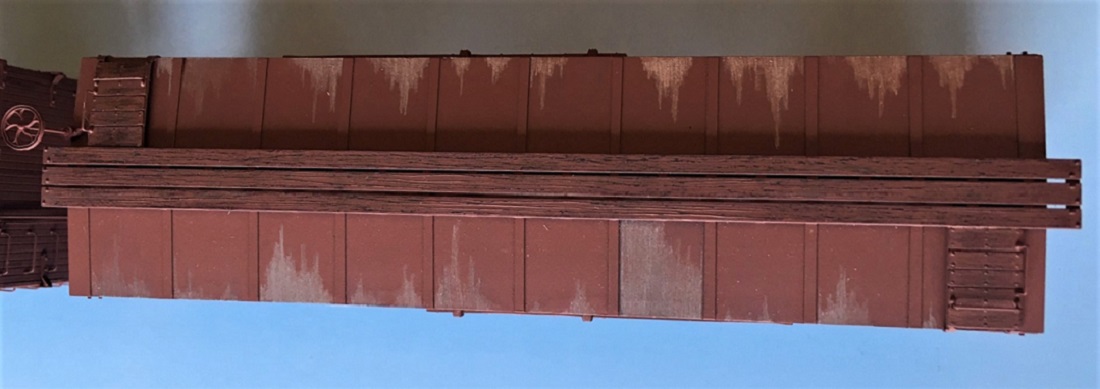 This one turned out a bit exaggerated. Roof walks done the same way as the car sides. 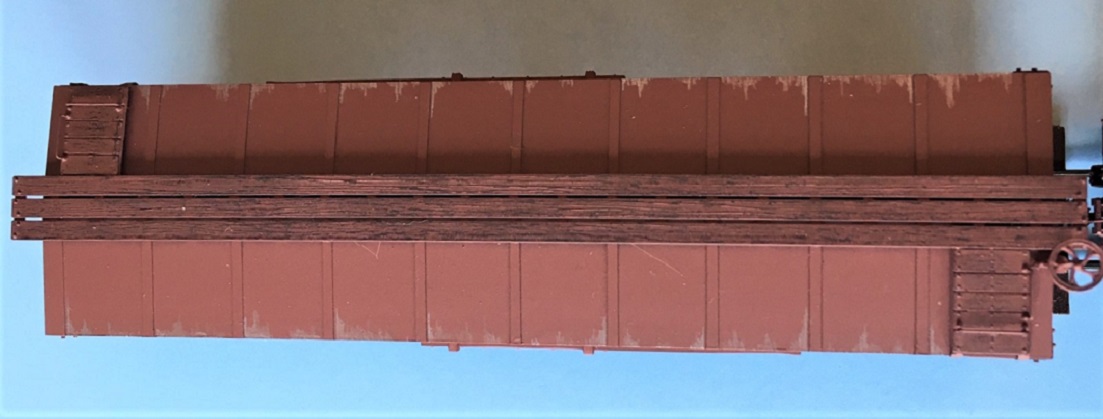 This one is a bit more subtle. In color prototype photos, the ribs themselves seem to retain paint better than the panels in between. Thoughts??
Jim Courtney
Poulsbo, WA |
Re: C&S Outside Metal Roofs -- Painting and Weathering Models
|
In reply to this post by Jim Courtney
I too believe that roof walks were painted. having owned a full scale wooden caboose until recently I had to deal with this issue, as it is a currently operable car. the solution was and still is to throw sand in the paint to provide an abrasive surface. yes in later years they didn't get maintained and became the weathered wood.
|
Re: C&S Outside Metal Roofs -- Painting and Weathering Models
|
In reply to this post by Jim Courtney
Jim
A couple thoughts. Paint on galvanized metal. Some 30 years ago I painted al lot of the galvanized flashing on my house. An old time painter told me that I had to clean it first to remove oil from manufacturing and use a coating that looked like contact cement, but without the "tack" before painting. When it was taken off last December, most of the paint was gone and rust was beginning to show. I just removed a couple hundred galvanized screws from a wooden sidewalk that are installed some 20 years ago. Almost all the zinc was gone and the rust appears to be the same color as the roof in the RGS train. My first reaction to the photo was that the panels had "rusted", about what I would expect after nearly 50 years. Pat |
Re: C&S Outside Metal Roofs -- Painting and Weathering Models
|
This is a great thread, I'm a very primitive rolling stock painter and I'll learn a lot.
About the RGS stock car roof, I agree with Pat. I used to live next to an old barn that had a metal roof probably from the same era. I don't know if it was originally galvanized but by the late 1960's when I knew it, it was rusted and looked, as I remember, just like this. I remember being impressed by how uniform the surface was, because it seemed surprising to me. I got to know it well because I helped make some repairs to it. I took the RGS photo and played with the color balance to see if I could make it look like paint. Nothing I could do that kept the sky, trees and brush colors reasonable changed the roof color much, still looks exactly like that old rusted steel to me. Here's a slightly tweaked version that I think comes closest to realistic colors overall: 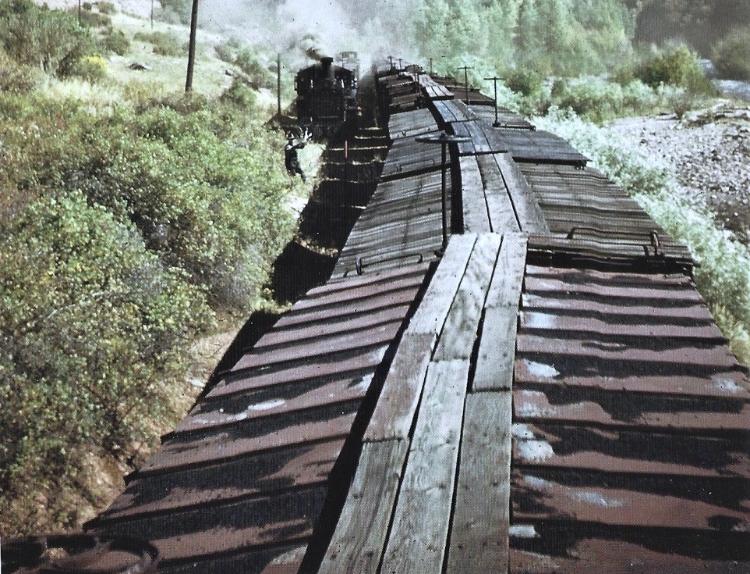 Cheers, John
John Greenly
Lansing, NY |
Re: C&S Outside Metal Roofs -- Painting and Weathering Models
|
Pat and John,
So if the panels between the ribs are mostly rusted, not with a residual layer of paint, how do you explain the occasional light patches?? Are those areas of bare galvanized metal, not yet rusted??
Jim Courtney
Poulsbo, WA |
|
The subject roof walks comes up in many of the forums. I can't understand how people can think the railroad would not protect a wood surface with paint. It is so exposed to elements and wear that it gets worn faster than any other part of the car but they were painted. I have worked over 30 cars in Chama ( many wearing D&RGW era paint) everyone showed evidence of paint on the roof walks. The murphy roofs I have worked on were not heavily rusted but covered with very old, faded and worn paint. But I have seen pictures of some that were heavily rusted. The top picture here is a good example. The car in the rear at the left is brightly rusted but looking at it I would say it was because it was in a fire. All pics were giving to me by Dick Dorman when were were discussing this subject years ago.
I have simulated the cinders on locomotive running boards by sanding a black pastel chalk onto them after wetting with a glue solution. I've been meaning to try it on freight roofs. Tony Kassin 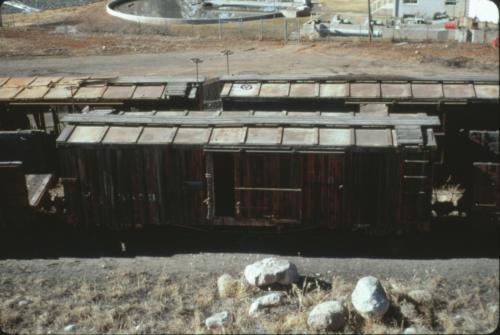 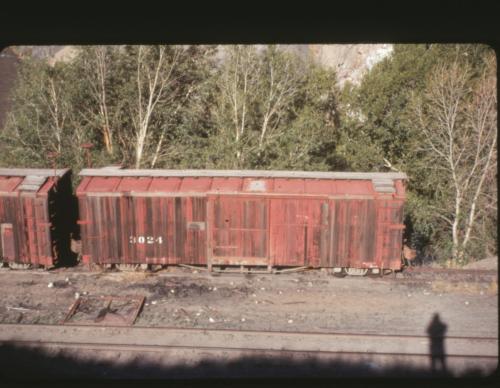 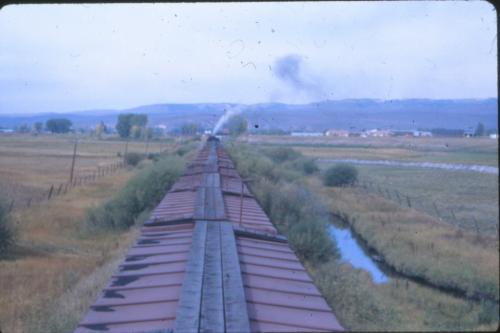 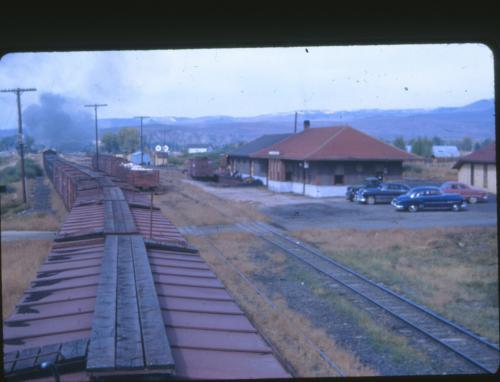  |
|
A larger copy of those two
 
|
Re: C&S Outside Metal Roofs -- Painting and Weathering Models
|
In reply to this post by Jim Courtney
Jim
Thickness of zinc, method of application, more paint applied, etc. I worked in a structural steel fabricating mill. Paint was applied using an airless apparatus with a hand gun much the railroads used. A a manual process the gun often dripped whenever the painted stopped. While fairly uniform, there were areas in higher mill thickness. Paint specs only called for minimum mill thickness and color. As to the screws I removed, their heads varied from a few that looked like they were fresh out of the box, the rest had varying areas of rust, mostly 75% to fully rusted. Pat |
Re: C&S Outside Metal Roofs -- Painting and Weathering Models
|
In reply to this post by Jim Courtney
One thing to remember Jim, the CM was a subsidiary of the AT&SF and the C&S/RGW the better part of its life. The sand in the paint makes a lot of sense.
Also, the buildup of cinders on the metal roof shows why there were so many car fires before the advent of metal roofs.... Rick |
«
Return to C&Sng Discussion Forum
|
1 view|%1 views
| Free forum by Nabble | Edit this page |

